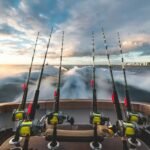Modern fishing technology has been with us for some time now. It has contributed significantly to the efficiency and safety of fishing activities. Technological advancements have transformed the fishing sector to increase cost-effectiveness in food production while limiting the human intervention in executing these roles.
Sustainable Fish Tracking
From the recreational angler fishing inshore to the commercial fisherman arranging lobster traps equipped with GPS locators to keep tabs on where their meals are moving. You can choose to monitor wherever the fish is going. Accessing today’s modern fish monitoring systems enables the provision of exact information concerning fish migration and adjacent regions.
Smart fishing gear
introduced smart fishing gear reduces bycatch, capturing unintended species such as dolphins, turtles, and juvenile fish. LED-equipped nets lure target species and discourage the bycatch while an acoustic pinger on nets alerts dolphins and whales acoustically and brings them far away. This smart gear results in vibrant marine ecosystems.
Aquaculture tech
in aquaculture, sensor technology is used to monitor the water quality parameters such as temperature, oxygen levels, and pH. Proper conditions are thus maintained for fish farming as the automated feeding systems deliver the best response rates. The need for an appropriate amount of feeds is maintained for growth rates and the overfeeding causes waste product formations.
Weather Forecasting
Advanced models of weather forecasts help fishermen make their trips more efficient. Knowing the occurrence of a storm or high waves, fishermen may avoid dangerous sea conditions, preserving their life and health and the integrity of their vessels.
Fish Processing Automation
Onboard and onshore, fish processing has been automated to clean, fillet, and package fish more quickly. This facilitates better quality of the catch and better food safety standards.
The Future of Fishing
In the near future, the predictions for fishing include the growing use of AI and machine learning to process and interpret more data types. The integration of drones and underwater remote operated vehicles will also increase, which will enable to see fish and their behavior in real time and make more immediate decisions.
Embracing Eco-Friendly Practices
However, on the more environmentally friendly front, it is also important not to forget about more sustainable limitiations for example, due to overfishing and its dangers that force to cancel fishing recreational activities. Lotman et al. go on to mention some technologies, such as 3D printing for creating more efficient lures, eco-friendly and biodegradable alternatives for recreationally fishing, and sensors or solar fishing systems that will require less energy and prevent spoilage.
The move towards sustainability is overall positive, largely due to troubling statistics regarding, for example, carbon emissions and plastic waste. For regulatory bodies.
The Digitalization of Fisheries Management
digitalization is not about processing data; it is immensely important for managing fish stocks. The authors of mention that accurate data about the number of fish caught and such undesirable side effects as bycatch help adjust regulations and focus on the prevention of overfishing and illegal, unregulated, and unreported fishing practices.
Conclusion
The combination of technology and fishing has brought many new possibilities. We live in the time of efficiency and sustainability, data-driven decisions, and the power of a community for the sake of oceans. However, with the further development of technologies, we must be ethical and sure that the technologies we are building nowadays will not destroy the marine biodiversity in the future.



